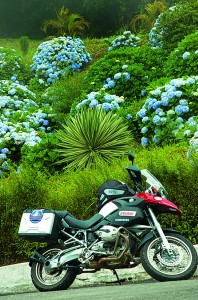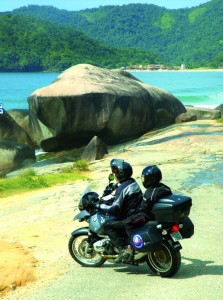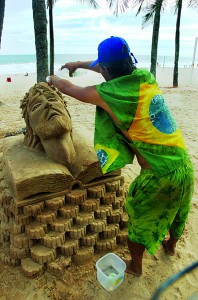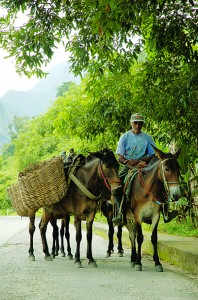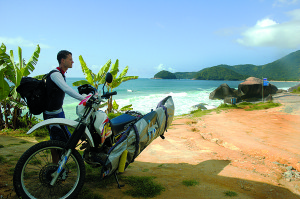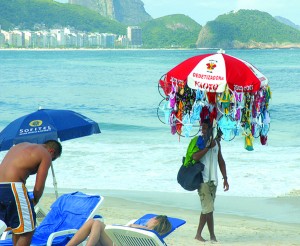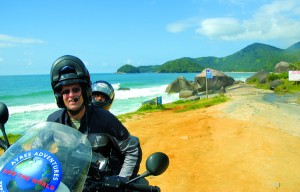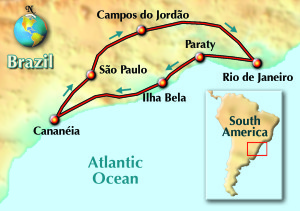There are 45,000 motorcycle couriers in São Paulo, the world’s third-largest city. On an average day, says Tour Director Mauricio Fernandes, one will earn his heavenly wings. Observing the busy, rain-slicked boulevards and the slim margins these daring deliverymen allow for conditions, I surmise that this day will not be average.
I’m most grateful for Fernandes’ foresight in launching our expedition from the outer suburb of Alphaville. And so are the others who’ve signed on for this Ayres Adventures “Surf and Turf—Brazil Style” tour. Eleven North Americans, slightly jet-lagged, strapped onto seven luggage-toting BMW motorcycles—not the best scenario for a crash course in guerilla commuting, but within minutes we’re winding down nicely wooded two-lane roads in a faint drizzle. Forty-five minutes later, we stop to stretch legs at a country store.
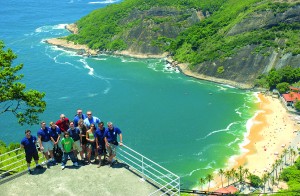
“I can’t believe I’m riding a motorcycle in Brazil!” exclaims gleeful Alan Resnick, a 58-year-old attorney from Chicago who in this moment seems more like a hooky-playing 13-year-old. We have one of those, too—young Spencer (aka “Monster”) Toothman of Cornelius, North Carolina, who’s hitched a ride on the back of an R1150GS piloted by Dr. Don Toothman.
For most in our group, this is the first time motorcycling abroad, and it shows in the tight formation, no one wishing to drop too far behind our leader. At our opening meeting, where we were introduced to a few basic Portuguese words and phrases, Jeff Smigla, a truck driver from Elk Mound, Wisconsin, summed up his anxiousness in one word. Told that there are two versions of the term “thank you”—obrigado for men and obrigada for women—he blurted nervously, “Omigawda!” Lombada is another Brazilian Portuguese word we quickly commit to memory. It’s not the dance of love, but rather a concrete interpretation of traffic law, intended to tear the oil pans from the engines of unscrupulous speeders. Our bikes (six of seven being GS models with generous ground clearance) enjoy a little more latitude. My passenger, MaryAnn, coins her own term: “Air Adventures!”
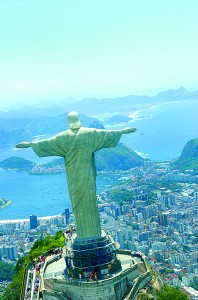
It’s afternoon before we break from the semicircle Mauricio has cleverly scribed around São Paulo. Following a late lunch in the town of São Bento do Sapucai, MaryAnn and I elect to enjoy a coffee and straggle behind for the remaining 40 kilometers to Campos do Jordão. MaryAnn, I suspect, just wants to try out the Portuguese she’s been eagerly ingesting from books and tapes for two months. The locals are patient. They look us in the eyes. They point on our map. There are two routes to Campos, they indicate. We want the rota sinuosa, I emphasize, remembering an earlier road sign. Their faces light up in agreement, as their hands, swimming like salmon, point toward the rota do moto.
Mile-high Campos is a sort of alpine theme town, set beneath Brazil’s last virgin pine forest in the Mantiqueira Mountains. The ascent is gorgeous—and a solid reminder that even though this is a pavement-only tour, it’s not one for novice riders. Up through the dense forest the smooth asphalt snakes on switchbacks greased with rain, horse manure, banana leaves and red mud. We rejoin the group taking photos at a towering waterfall that disappears into the mountain mist. Several hours later, dining in a private room of a tony restaurant, we huddle around the fireplace to keep warm. It’s Christmas season—summer here in the Southern Hemisphere—yet the temperature is colder than when I left Pittsburgh!
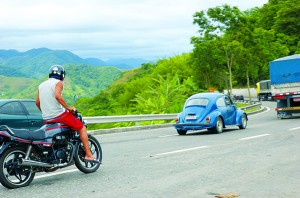
In the morning we quickly descend into cattle country (the Turf part of the tour), enjoying warmth and sunshine as we cross from São Paulo state into the state of Rio de Janeiro. With a day of riding under our collective belt, the group seems more relaxed and begins to spread out. Don and Spencer are working on what will be a brilliant photo documentary, and we marvel at their teamwork as the Monster expertly fires Dad’s Nikon at 60 mph.
The road is smooth, then bumpy, then smooth. Then bumpy, bumpy, bumpy, always with good, bouncy glimpses of Brazilian life: a rag-tag circus, kids cavorting in a waterfall, three proud “working girls” posed like Radio City Rockettes…across the road from the police inspection station!
Rio de Janeiro. We’ve all seen the photos of Sugar Loaf Mountain and the famous statue, Christ the Redeemer, towering above the bay, but we only have one day and two nights here—not nearly enough to get to know a city of 10 million people. Ron Ayres has an answer. Known in the motorcycle world for his record-breaking longdistance rides, Ayres is a retired executive whose résumé includes posts in South Africa and Brazil, the principal staging grounds for his growing network of global motorcycle tours. No doubt that career taught him what it takes to close a deal, and on this short, one-week vacation it’s the helicopter ride over Rio. If you do this trip, elbow, sweet-talk or bribe your way up front, next to the pilot’s seat. And pack your film and fresh batteries. This is the money shot.
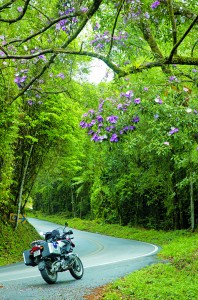
Still high on adrenalin, we walk for hours along the beaches of Copacabana, Ipanema and Leblon, where our hotel is situated. It’s no secret that South American cities suffer deep divisions between rich and poor, and perhaps nowhere is the divide deeper than Rio’s. But we are all naked under our clothes, and on that 100-foot-wide strip of sand all are equal…though in thong bikinis (called fio dental or “dental floss”) some are clearly more equal than others.
The sights are too numerous to mention: sand sculptors, roving bikini vendors, and hey, sports fans—how about futevolley, the extraordinary marriage of Brazil’s two favorite sports! Or maybe you’d just like to sit by the ocean and sip a cold coco?
Earlier in the tour, I’d asked Ayres (who normally looks after the company’s African operations but has joined us in Brazil on vacation), where were all the aggressive drivers I’d heard so much about?
“In Rio,” he deadpanned, and sure enough, both ingress and egress affirmed his wry assessment. But that’s behind us now, as we’re into the Surf portion of our ride. For nearly three days, the Costa Verde (green coast) will be our onagain/off-again companion, a sight I could never tire of. At Angra dos Reis, lush Atlantic rainforest rises 6,000 feet above white sand coves set in a turquoise archipelago of 365 islands.
The coastal road, the Rio-Santos Highway, doesn’t hug the cliffs in the manner of Big Sur Highway. Mostly, it keeps a respectful distance from the shore, sometimes granting spectacular views, other times curling into the hills for some fast sweeper action, while occasionally meandering down for a beachside visit. Near certain towns the traffic is heavy; other stretches are nearly deserted.
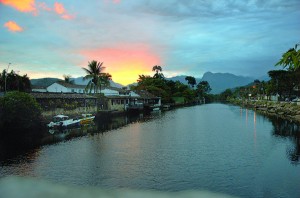
We overnight at Paraty, a colonial town more than 400 years old and a national monument, and at Ilha Bela (beautiful island). The latter requires a half-hour ferry ride, time we spend chatting with a local musician named Fernando who’s riding a Honda XR250. It’s not unusual to see Brazilians flogging such bikes at 75 mph, often two-up!
Though we’ve made our own way, Mauricio, who’s a two-time Paris-Dakar veteran with a 12th-place finish to his credit, has kept us on point with color-coded Dakar-style route sheets, including GPS waypoints. The Ayres team likes to make camp early, and both Paraty and Ilha Bela are great stops for walking, shopping and people-watching. In a week of pleasant hotels, Paraty’s 17th century Pousada do Sandi stands out for its atmospheric interior (our room overlooks the garden and pool) and exterior (where horsedrawn carts ply carfree cobblestone streets).
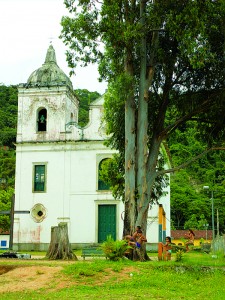
Our penultimate day is the most challenging. Brazil has the second highest truck traffic in the world, with exhaust stacks that shoot straight back at helmet level. This afternoon, heading inland with the temperature hovering around 100 degrees, we sniff every one of them. This is also the day we learn why people purchase guided tours; i.e. we (MaryAnn and I) get hideously, hopelessly lost while straying once again from the central cast. We wander through an industrial nightmare as black as midnight in hell, then zig-zag unwittingly up (and later down) the most amazing highway engineering feat I’ve ever seen. I lose count of the tunnels at around 12. Good Samaritans try to help us, but neither our pocket translator nor any amount of sign language helps. Finally, one of the 45,000 angels—a messenger who spends each day pounding a weedy little Honda back and forth between São Paulo and the port of Santos (bless his necrotic lungs)—leads us out of our nightmare and toward Cananeia, a sleepy island where our group will
spend the night. Costa Azul Club is an idyllic, shoes-off kind of place, where we’re treated to a private seafood banquet including lobsters the size of Labrador retrievers.
The final morning we stick close to the group. The curves are sweet, verged by cool, blue hydrangea and woodland cascades, reminding me of the first day’s ride to Campos do Jordão, though the blooming primavera trees now add a dreamy canopy of purple blossoms. A final treat before returning to Alphaville is lunch at a fast-food restaurant where dozens of delicious items, from couscous to ice cream, are all made from corn (which also fuels 4 million Brazilian cars).
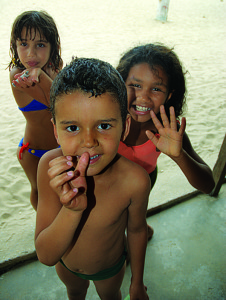
No one heads for their hotel rooms. We linger in riding gear for an hour, swapping hugs and memories. Having traveled with various tour companies, I’ve noted that what customers remember best isn’t the hotels or the roads, so much as the personal treatment shown by their hosts. In addition to the usual T-shirts, we each receive gift bags of cachaca (sugar cane liquor) and a kit for making caiparinha (Brazil’s national drink). Nice touches, but the look on young Spencer’s face as he dons the beautiful green and gold Brazil soccer jersey awarded by Mauricio is a clearer indication of the thoughtfulness behind the gifts.
No tour company is perfect, and we have to ding Ayres Adventures in one not insignificant area. In the end we’d enjoyed a wonderful vacation—good food, stunning scenery, nice hotels—but we had to look beyond our leaders when we craved detailed commentary on the fascinating places we visited. In a fun-filled week, there was scarcely any mention of Brazilian art, history, politics or literature. Before flying home, about half of our group signed on for a guided tour of São Paulo, including a visit to the Pinateca Museum, an experience which brought meaning to many of the pretty pictures we’d seen over the week. Believe me, we saw a lot of them, and that helicopter ride—talk about an Air Adventure!
Surf & Turf at a Glance
South America’s largest country is big; 27 states (we only visited two) comprising a land mass slightly larger than our lower 48 states. The Brazilian government was not pleased when our immigration authorities started fingerprinting last year, so expect to stand in line an extra half-hour at Brazilian airports awaiting their retaliatory gesture, a digital scan of your index finger. You’ll also pay a hefty visa fee ($162.50 when processed through a document service).
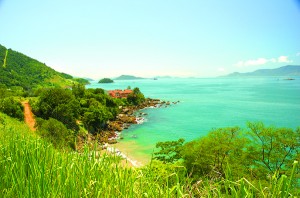
Once you’ve cleared the airport (flight time—eight hours from Miami, plus one- or three-hour time change, depending upon the time of year), you’re unlikely to sense any tensions. The people are warm, outgoing and diverse (in São Paulo we passed a Japanese McDonald’s).
Speaking of burgers, no surprise here that Brazilians are big meat eaters. The churrascaria, gaining popularity in the United States, is a carnivorous orgy in which diners are assaulted with skewered barbeque until they beg the waiters to desist. Of course, the accompanying buffets are also lavished with seafood, salads and ummm, desserts.
Of practical interest, note that gasoline is slightly more expensive than in the United States. Best to carry more than one credit card (MasterCard is most widely accepted), and ATMs are a bit dicey—so carry a few days’ worth of reals (pronounced heh-eyes). Toll roads are free to motorcyclists!
Drivers are aggressive, but rarely in a malicious way. Lane markings mean nothing, so live in your mirrors. I’d recommend the tour to good, solid intermediate riders. Any misgivings about cobblestones and steep terrain, opt for the smaller F650GS.
English is not widely spoken, except at big-city hotels. Your high-school Spanish will help you interpret many signs. Speak it very slowly and people will usually get the gist (too bad they’ll answer in Portuguese!).
Tour cost at this writing is $3,600 ($2,750/passenger), and includes motorcycle, support van, eight nights’ lodging, seven dinners and all breakfasts. Surf & Turf runs May and December; other South American tours year-round. See www.ayresadventures.com or call (800) 710-8016.
(This article was published in the July 2005 issue of Rider.)

